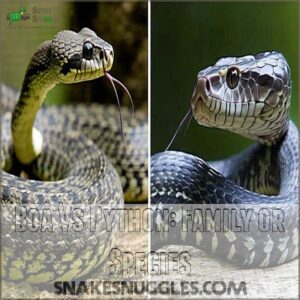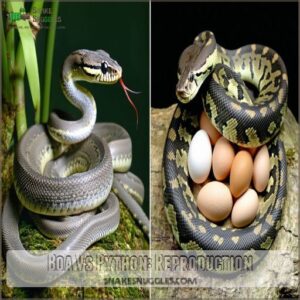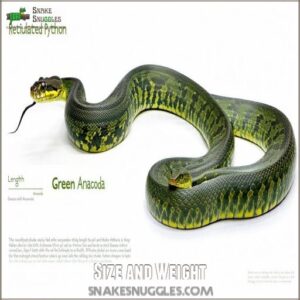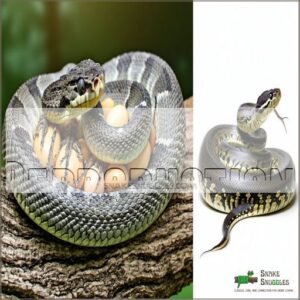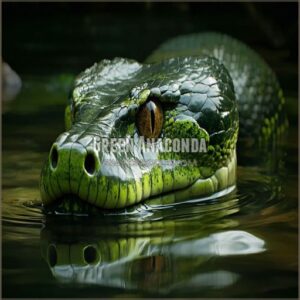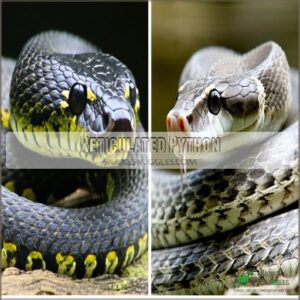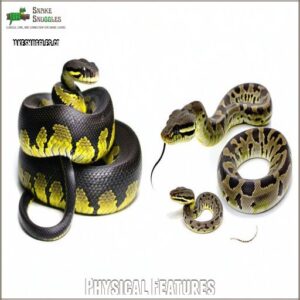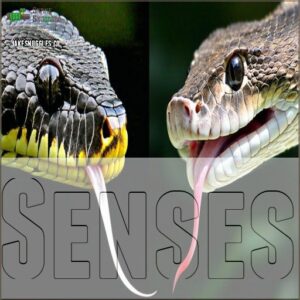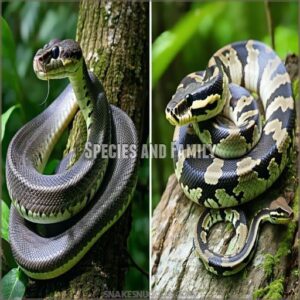This site is supported by our readers. We may earn a commission, at no cost to you, if you purchase through links.
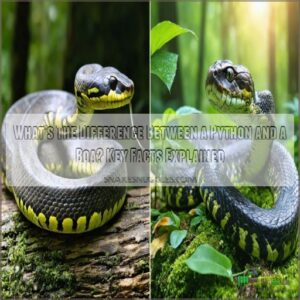 Wondering what’s the difference between a python and a boa? It’s all about where they live, how they reproduce, and even their anatomy.
Wondering what’s the difference between a python and a boa? It’s all about where they live, how they reproduce, and even their anatomy.
Pythons, hailing from Africa, Asia, and Australia, lay eggs (oviparous) and sport extra teeth in their premaxilla bones. Boas, found in the Americas, give live birth (ovoviviparous) and skip the extra teeth.
Pythons usually grow much larger—up to 33 feet—while boas max out at around 13 feet.
Both have heat-sensing pits to track prey, but a python’s are sharper. Think of boas as the rainforest ambushers and pythons as the long-reaching giants.
Curious about their record-holders? Keep reading!
Table Of Contents
- Key Takeaways
- Comparing Boa Vs Python
- Habitat and Range
- Anatomy
- Size and Weight
- Reproduction
- Notable Giant Species
- Physical Features
- Senses
- Movement
- Species and Family
- Frequently Asked Questions (FAQs)
- Are a boa and a python the same thing?
- How do you tell if a snake is a boa?
- Are boas or pythons better pets?
- What is the difference between a snake and a python?
- Which is easier to handle as a pet?
- What are their typical lifespans?
- How much do they cost to acquire?
- What are their specific dietary needs?
- How much space do they require?
- Conclusion
Key Takeaways
- You’ll find pythons in Africa, Asia, and Australia, laying eggs, while boas live in the Americas and give live birth.
- Pythons grow significantly larger, reaching up to 33 feet, whereas boas max out around 13 feet but are typically bulkier.
- Pythons have more teeth and sharper heat-sensing pits, while boas feature narrower heads and fewer teeth.
- Pythons thrive in diverse habitats, from jungles to deserts, while boas stick to tropical rainforests and grasslands.
Comparing Boa Vs Python
You might think pythons and boas are similar, but their differences go beyond size and looks.
By comparing their family groups, habits, and habitats, you’ll see how unique each one truly is.
Boa Vs Python: Family or Species
Unravel the evolutionary mystery of boas and pythons, tracing their genetic roots back in time together.
Boa Vs Python: Size and Weight
Pythons tend to outgrow boas, stretching 3-30 feet versus boas’ 6-10 feet.
Weight variations align proportionally, with boas typically weighing 20-45 kg (45-100 lbs) as adults, which can fluctuate based on factors like boa constrictor weigh.
Here’s a quick python vs boa size breakdown:
| Type | Average Size | Maximum Length | Growth Rate |
|---|---|---|---|
| Boa | 6-10 feet | 13 feet | Fast (initial) |
| Python | 3-30 feet | 33 feet | Rapid (varies) |
Boa Vs Python: Location and Habitat
Let’s talk geography! Boas stick to the Americas, thriving in tropical rainforests teeming with heat and prey.
Meanwhile, pythons roam Africa, Asia, and Australia, adapting to deserts, grasslands, and jungles.
Both snakes occasionally perch in trees, showcasing their arboreal flair.
| Feature | Boa Habitat | Python Habitat |
|---|---|---|
| Location | Americas | Africa, Asia, Australia |
| Climate | Tropical rainforests | Diverse environments |
| Lifestyle | Arboreal and ground-dwelling | Highly adaptable |
Boa Vs Python: Reproduction
Boas have a unique reproductive strategy known as ovoviviparity process, which involves giving birth to live young after a 100-120 day gestation period.
Boas have live births; pythons lay eggs.
That’s the short, sweet version of their reproductive differences.
Boa Vs Python: Appearance and Coloring
You’ve probably noticed differences in python and boa constrictor physical characteristics already.
Habitat and Range
When comparing the habitats of boas vs pythons, their geographic distribution highlights fascinating differences. Boas, like the boa constrictor, claim Central and South America as their stronghold, thriving in tropical rainforests, grasslands, and even arid regions, where they often inhabit arboreal habitats.
In contrast, pythons rule over continents like Africa, Asia, and Australia, from desert landscapes to lush jungles. Though they inhabit different areas, their adaptability is impressive, with some species crossing boundaries, such as the invasive Burmese python thriving in Florida’s subtropical Everglades.
Both snakes are adept at their environments. Their heat-sensing pits work like built-in infrared cameras, helping them hunt warm-blooded prey even in total darkness. As a nod to their evolutionary past, both have vestigial limbs—tiny remnants of functional legs.
The green anaconda, a powerhouse boa, dominates waterways in the Amazon Basin, while the reticulated python, hailing from Southeast Asia, claims the title of the world’s longest snake, stretching over 30 feet.
Anatomy
In the epic showdown of python vs. boa constrictor, their anatomy tells a fascinating story.
Pythons have bonus bones in their upper jaws—premaxillae—armed with extra teeth, while boas skip these.
Both evolved with two lungs (most snakes have just one!) and possess vestigial limbs near their tails, tiny nods to their ancient leggy ancestors.
Importantly, pythons, belonging to the family Pythonidae, use their heat-sensing pits to detect warmth of prey in the dark.
Boas boast narrower heads and fewer teeth compared to pythons’ robust skulls and muscular builds.
Heat-sensing pits on a python’s lips make hunting warm-blooded prey precise, while their glossy scales and rigid builds provide a predatory edge. Boas, though sleeker, hold their own!
Size and Weight
Boa constrictors and pythons showcase fascinating differences in size and weight.
For a detailed look at boa constrictor growth and size variations, check out this helpful boa constrictor size chart.
While boas typically range from 4 to 12 feet, pythons often grow much larger. Some, like the reticulated python, are true giants, stretching over 30 feet – imagine a snake longer than a school bus!
On the other hand, the boa family takes the crown for sheer bulk. The green anaconda, a type of boa, is a heavyweight champ, tipping the scales at over 500 pounds with a body thicker than a grown person’s waist.
In general, boas have slower growth rates compared to pythons, which can reach impressive sizes faster.
Comparing python size vs boa size reveals that pythons usually outmatch boas in length, but boas hold their ground in body mass.
The boa constrictor versus python size debate often fascinates snake enthusiasts worldwide.
Reproduction
Reproduction is one of the big ways boas and pythons stand apart. Boas are ovoviviparous, meaning they give live birth. Their young develop inside eggs that stay within the mother’s body until they’re ready to emerge. This approach boosts survival rates since the babies arrive fully formed and protected during development.
Pythons, however, take a different route—they’re oviparous, laying eggs that hatch outside the body. These eggs require careful incubation, often with the mother coiling around them to provide warmth and protection.
| Characteristic | Boa Constrictor | Python |
|---|---|---|
| Reproductive Type | Ovoviviparous | Oviparous |
| Birth | Live young | Lays eggs |
| Gestation Period | Shorter | Longer |
| Offspring Survival | Higher | Lower |
Pythons show incredible dedication during incubation, using muscle contractions to generate heat.
Boas, in contrast, might seem less involved—they focus on bringing fully developed offspring into the world, requiring less follow-up. Both strategies highlight fascinating adaptations suited to their environments.
Notable Giant Species
You’ll now explore some truly massive snakes, like the Green Anaconda, a boa known for its incredible size and South American habitat.
The Reticulated Python, a python species found in Asia that holds the title of the world’s longest snake.
These giants showcase the impressive diversity in size and distribution within both python and boa families.
Green Anaconda
The green anaconda, the world’s heaviest snake, thrives in the Amazon basin’s murky waters. Unlike pythons, it’s a stealthy, water-bound hunter relying on strength, not venom.
- Massive size: Reaching over 10 meters.
- Hunting style: Ambushes prey like capybaras or caimans.
- Conservation: Threatened by habitat loss and hunting.
Its lifespan averages 10-12 years.
Reticulated Python
Meet the reticulated python, the longest snake in the world. Found in Southeast Asia’s rainforests, these snakes can grow up to 32 feet long.
| Characteristic | Fact |
|---|---|
| Diet | Small mammals, birds, reptiles |
| Habitat | Rainforests, grasslands, wetlands |
| Temperament | Generally calm, but can be aggressive |
Reticulated pythons face threats from habitat loss and the pet trade, making conservation efforts essential to protect these majestic creatures.
Physical Features
You can spot the difference between a python and a boa by their distinct physical traits, like head shape and scale patterns.
Pythons tend to have bigger heads and more bold coloring, while boas are slimmer with a more uniform color palette.
Habitat Range Differences
Boas stick to the Americas, favoring tropical rainforests with thick vegetation and humid climates.
Pythons, however, span Africa, Asia, and Australia, thriving in grasslands, deserts, or forests.
Florida’s invasive Burmese python shows how human actions can shift geographic distribution, creating unexpected habitat overlaps.
Anatomical Distinctions
Let’s explore the anatomy! You’ll find key differences between pythons and boas. Check these out:
- Head shape: Boas have narrower heads; pythons have broader ones.
- Tooth count: Pythons boast more teeth than boas.
- Scale texture: Both have smooth scales, but there are subtle differences.
Notable Species Comparisons
The green anaconda thrives in Amazonian swamps, earning its title as the heaviest snake, stretching beyond 20 feet. In contrast, the reticulated python of Southeast Asia claims the longest snake record, exceeding a jaw-dropping 32 feet. Meanwhile, boa constrictors typically reach notable lengths that can be found in boa constrictor size charts related to average snake lengths.
- Notable Sizes: Anacondas dominate with their bulk, while reticulated pythons excel in length.
- Color Patterns and Prey Choices: Anacondas flaunt olive-green hues for camouflage, ambushing aquatic prey; reticulated pythons display intricate net-like patterns, preying on land mammals.
Senses
Regarding senses, pythons have a leg up—well, hypothetically. Their heat-sensing pits, lined with infrared receptors, act like night vision goggles, letting them track warm-blooded prey even in the pitch dark. This ability to detect subtle heat differences is one of the coolest tricks in the reptile world.
Boas aren’t slouches either; their heat receptors, located on their lips and face, help them find prey and regulate body temperature, though they’re not as fine-tuned as the python’s.
Both species rely on more than just heat detection. Python vision and boa hearing are sharp enough to pick up movement and sound in their surroundings.
Add to that their ability to “taste” the air with their tongues, and it’s clear that the differences between boas and pythons come down to specialization in their sensory arsenals.
Movement
Picture yourself observing a python and a boa in motion – you’ll notice distinct locomotion styles known as caterpillar or rectilinear movement.
- Body Mechanics: Both snakes use muscle coordination to push their bodies forward in a straight line. Enthusiasts interested in python boa movement can find related products online, such as those available at python boa gear.
- Speed Comparisons: Boas tend to be slower than pythons, but both can move quickly when hunting.
- Hunting Techniques: Their unique movement allows them to navigate dense habitats and catch prey off guard.
- Muscle Structure: Pythons and boas have powerful muscles that enable their distinctive movement patterns.
Species and Family
Boas and pythons come from two distinct families of snakes, each with fascinating taxonomic classifications. Boas belong to the Boidae family and give birth to live young (ovoviviparous), while pythons, part of the Pythonidae family, lay eggs (oviparous).
Geographically, boas stick to the Americas, thriving in rainforests, while pythons dominate Asia, Africa, and Australia.
You’ll find boas favoring tree-dwelling (arboreal) habitats, while pythons branch out between trees and the ground.
Boas prefer stealthy ambushes, compared to the active pursuit style of pythons, although both use constriction to subdue prey.
Habitat loss and illegal trade threaten both families.
Understanding these evolutionary histories and genetic relationships highlights their uniqueness and underscores why preserving these species is essential for biodiversity.
| Feature | Boa | Python |
|---|---|---|
| Family | Boidae | Pythonidae |
| Breeding | Ovoviviparous | Oviparous |
| Habitat | Arboreal | Arboreal or terrestrial |
| Hunting | Ambush | Constriction |
| Conservation Status | Threatened | Threatened |
Frequently Asked Questions (FAQs)
Are a boa and a python the same thing?
Think of boas and pythons as distant relatives.
While both are heavy-bodied constrictors, boas give live birth, and pythons lay eggs.
Boas thrive in the Americas, but pythons call Africa, Asia, and Oceania home.
How do you tell if a snake is a boa?
You can identify a boa by its narrower head, smooth scales, reddish or brown tail markings, and native range in the Americas.
Unlike pythons, boas give live birth instead of laying eggs.
Are boas or pythons better pets?
It depends on your preference.
Pythons, especially ball pythons, are calmer and easier to care for, while boas are more active and curious.
Both thrive with proper handling, but their size and needs differ.
What is the difference between a snake and a python?
Not all snakes are pythons.
Snakes make up a broad category of reptiles.
Pythons are just one family with distinct traits like laying eggs, heat-sensing pits, and being native to Africa, Asia, and Oceania.
Which is easier to handle as a pet?
Ball pythons are easier to handle thanks to their calm, docile nature, perfect for beginners.
Boas, while curious and active, can be more defensive when unaccustomed to interaction, requiring experienced handling to guarantee safety.
What are their typical lifespans?
Boa constrictors typically live 20-30 years.
Pythons’ lifespans vary greatly by species, from 10-30 years.
A ball python might live 20-30 years, but a Burmese python could only live for 10-
How much do they cost to acquire?
Getting a boa or python isn’t cheap. Ball pythons usually range from $50 to $500 depending on morphs, while boas often cost $200 to $1, Rarer species or morphs can climb into the thousands.
What are their specific dietary needs?
You’ll need to feed both pythons and boas warm-blooded prey like rodents or birds.
Younger snakes eat more often, around once a week.
Adults usually eat every two to four weeks, depending on size.
How much space do they require?
Think of their enclosures as private kingdoms.
Boas need at least 6-8 feet of space.
Pythons, depending on species, require enclosures ranging from 3-10 feet, ensuring room to stretch, climb, and hide comfortably.
Conclusion
Turns out, the difference between a python and a boa isn’t a small detail—it’s a whole lifestyle.
From pythons’ remarkable size and egg-laying habits to boas’ efficient live births and exclusive American range, these snakes prove nature’s creativity.
Pythons dominate with size and extra teeth, while boas thrive with adaptability. Pythons and boas have different lifestyles.
If you’re still wondering "what’s the difference between a python and a boa?" just remember: it’s all about habitat, anatomy, and how they bring their little ones into the world.

